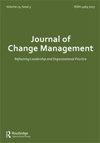变革态度与变革型领导:一项纵向研究
IF 3
Q2 MANAGEMENT
引用次数: 10
摘要
摘要我们在两个组织(N = 165)。对特定变化的准备程度(状态准备程度)和对变化的普遍抵抗力(特质抵抗力)进行了测量。状态准备度在时间点(r = .50),并且随着时间的推移显著增加。相反,性状抗性没有表现出随时间的显著变化,但在时间点之间表现出显著的相关性(r = .62)。在时间1(r = .46)和时间2(r = .47),但与任一时间点的性状抗性均不相关。分层回归显示,组织、时间1的状态准备、时间2的特质抵抗和时间2的变革型领导的变量额外解释了时间2状态准备的46.5%的差异。讨论了这些结果对变革管理理论的启示。MAD声明领导者被认为在影响员工实施组织变革方面发挥着关键作用。目前尚不清楚使用转型行为的领导者是否会对员工对变革的态度产生短期和/或长期的影响。一项针对相隔几个月的两个时间点的员工的调查显示,变革型领导与对特定变化的态度有着显著的同时但并不持久的联系。因此,最初为塑造员工态度所做的大量领导努力可能会被浪费。然而,这些结果也意味着,在变革开始时的领导失误可能会在实施过程中得到纠正。本文章由计算机程序翻译,如有差异,请以英文原文为准。
Attitudes toward Change and Transformational Leadership: A Longitudinal Study
ABSTRACT We examined the malleability of two frequently-cited attitudes toward change and their relationship with transformational leadership using a repeated measures design for two time points separated by six to eight months in two organizations (N = 165). Readiness for a specific change (state-readiness) together with generalized resistance to change (trait-resistance) were measured. State-readiness showed a significant correlation between time points (r = .50) and a significant increase over time. In contrast, trait-resistance did not show a significant change over time but did show a significant correlation between time points (r = .62). Transformational leadership was correlated with state-readiness at both Time 1 (r = .46) and Time 2 (r = .47) but was not correlated with trait-resistance at either time point. A hierarchical regression revealed that the variables for organization, state-readiness at Time 1, trait-resistance at Time 2, and transformational leadership at Time 2 additively explained 46.5% of variance in state-readiness at Time 2. The results are discussed with respect to their implications for change management theories. MAD statement Leaders are thought to play a key role in influencing employees to implement an organizational change. Less is known whether leaders, who use transformational behaviours, will have a short-term and/or longer lasting influence on employee attitudes toward change. A survey of employees at two time points several months apart revealed that transformational leadership had a significant concurrent, but not lasting, association with attitudes toward a specific change. Consequently, sizeable initial leadership efforts to shape employee attitudes that are not sustained may be wasted. However, these results also mean that mistakes in leadership at the start of a change may be correctable over the course of implementation.
求助全文
通过发布文献求助,成功后即可免费获取论文全文。
去求助
来源期刊

JOURNAL OF CHANGE MANAGEMENT
MANAGEMENT-
CiteScore
6.60
自引率
20.00%
发文量
14
期刊介绍:
Journal of Change Management is a multidisciplinary and international forum for critical, mainstream and alternative contributions - focusing as much on psychology, ethics, culture and behaviour as on structure and process. JCM is a platform for open and challenging dialogue and a thorough critique of established as well as alternative practices. JCM is aiming to provide all authors with a first decision within six weeks of submission.
 求助内容:
求助内容: 应助结果提醒方式:
应助结果提醒方式:


